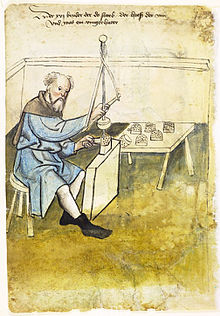Racing spindle
The racing spindle , also known as Dreule , Tanzmeister or drilling spindle , is a device for manually driving a drill and is used to generate circular, approximately cylindrical bores. The racing spindle consists of a shaft (spindle) with the drill, a flywheel on the lower part of the shaft and a drill handle that is movably guided over the spindle and is connected to the spindle head by belts or bands.
Working principle
By turning in the drill spindle to a certain extent, the bands wrap around the spindle in opposite directions as a double helix and pull the drill handle perforated in the middle up a little. By vigorously pressing down the twist grip by hand, the spindle is set in rapid rotation and the drill is pressed down at the same time. At the latest at the bottom dead center , the twist grip must be relieved so that the momentum of the flywheel can continue to turn the spindle in order to rewind the tapes, but in the opposite direction, whereby the twist grip is raised again. By further rhythmic pressing down and letting the drill handle rise again, an alternating rotary movement of the drill spindle with the drill is achieved.
If the drilling spindle is only supported with the drill in the borehole below and if it is oriented approximately vertically, the angular momentum stabilizes the position of the spindle axis. The weight of the twist grip creates a certain idle tensile force in the straps, which causes them to wind up evenly. With axial support of the free end of the spindle - for example with the tip of a thumb - and particularly careful guidance of the twist grip, it is also possible to drill vertically upwards. If the drill bit must be horizontal, the rear end of the spindle is oriented exactly in position and are supported on axial thrust, so that the spindle does not by its gravity downward tilt or sideways through centrifugal forces präzedierend drifts. Again, properly guiding the twist grip is difficult. The ideal drilling direction is vertically downwards.
history
The racing spindle is one of the early mechanical hand drills , was already known to the Romans and was used until the present day, when it was replaced by more modern drilling equipment and later by drilling machines . Today, racing spindles are mainly used to depict historical craft techniques.
literature
- Thomas Eisenblätter, Kurt Häuser: The racing spindle . Deutsches Museum, Munich 1994
Web links
Individual evidence
- ^ Günther Spur: On the change in the industrial world through machine tools , 1991, p. 89.

